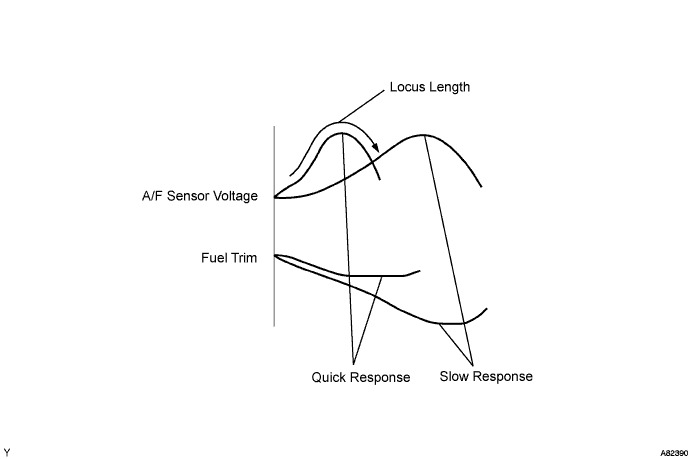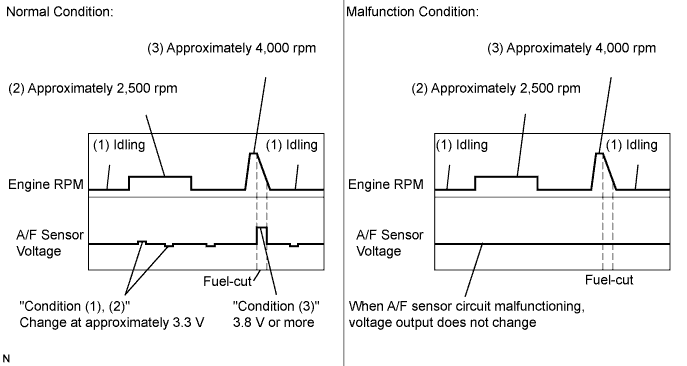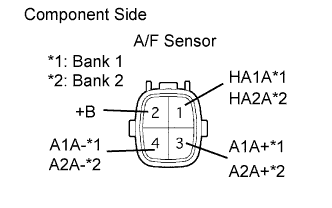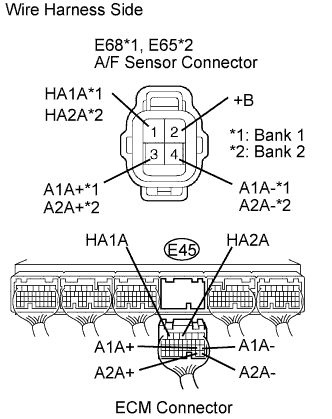CHECK ANY OTHER DTCS OUTPUT (IN ADDITION TO DTC P2A00 AND/OR P2A03)
READ VALUE USING INTELLIGENT TESTER (OUTPUT VOLTAGE OF A/F SENSOR)
PERFORM CONFIRMATION DRIVING PATTERN
CHECK WHETHER DTC OUTPUT RECURS (DTC P2A00 AND/OR P2A03)
PERFORM CONFIRMATION DRIVING PATTERN
CHECK WHETHER DTC OUTPUT RECURS (DTC P2A00 AND/OR P2A03)
CONFIRM WHETHER VEHICLE HAS RUN OUT OF FUEL IN PAST
INSPECT AIR FUEL RATIO SENSOR (HEATER RESISTANCE)
CHECK HARNESS AND CONNECTOR (A/F SENSOR -ECM)
CHECK FUEL PRESSURE (HIGH PRESSURE SIDE)
PERFORM CONFIRMATION DRIVING PATTERN
CHECK WHETHER DTC OUTPUT RECURS (DTC P2A00 AND/OR P2A03)
CONFIRM WHETHER VEHICLE HAS RUN OUT OF FUEL IN PAST
DTC P2A00 A/F Sensor Circuit Slow Response (Bank 1 Sensor 1) |
DTC P2A03 A/F Sensor Circuit Slow Response (Bank 2 Sensor 1) |
DESCRIPTION
- DTC P2A00 indicates malfunctions related to the bank 1 A/F sensor.
- DTC P2A03 indicates malfunctions related to the bank 2 A/F sensor.
- Bank 1 refers to the bank that includes cylinder No. 1.
- Bank 2 refers to the bank that includes cylinder No. 2.
- Sensor 1 refers to the sensor mounted in front of the Three-Way Catalytic Converter (TWC) and located near the engine assembly.
| DTC No. | DTC Detection Condition | Trouble Area |
| P2A00 P2A03 | Air-Fuel Ratio (A/F) sensor circuit slow response: Under condition (a), (b) and (c), A/F sensor output voltage changing value below regular changing value in comparison with fuel trim changing value (2 trip detection logic): (a) Warm engine (b) Driving at engine speed of between 1,400 rpm and 3,200 rpm (c) Vehicle speed between 37.5 mph and 75 mph (60 km/h and 120 km/h) |
|
MONITOR DESCRIPTION

The output voltage of the A/F sensor varies in proportion to the air-fuel ratio. Based on these voltage variations, the ECM determines whether the actual air-fuel ratio is rich or lean, and makes adjustments to bring it close to the stoichiometric level. In addition, the ECM checks the fuel injection volume compensation value to determine whether the A/F sensor response time is normal or slow. The ECM calculates the ratio of the variations in both A/F sensor output voltage and the fuel trim value.
WIRING DIAGRAM
Refer to DTC P2195 on page Click here.INSPECTION PROCEDURE
- HINT:
- Intelligent tester only:
- Malfunctioning areas can be identified by performing the Control the Injection Volume for A/F Sensor function provided in the Active Test. The Control the Injection Volume for A/F Sensor function can help to determine whether the Air-fuel Ratio (A/F) sensor, Heated Oxygen (HO2) sensor and other potential trouble areas are malfunctioning.
- Connect the intelligent tester to the DLC3.
- Start the engine and turn the tester ON.
- Warm up the engine at an engine speed of 2,500 rpm for approximately 90 seconds.
- On the intelligent tester, enter the following menus: Power train / Engine / Active Test / Control the Injection Volume for A/F Sensor.
- Perform the Control the Injection Volume for A/F Sensor operation with the engine in an idling condition (press the RIGHT or LEFT button to change the fuel injection volume).
- Monitor the output voltages of the A/F and HO2 sensors (AFS B1 S1 and O2S B1 S2 or AFS B2 S1 and O2S B2 S2) displayed on the tester.
- HINT:
- The Control the Injection Volume for A/F Sensor operation lowers the fuel injection volume by 12.5 % or increases the injection volume by 25 %.
- Each sensor reacts in accordance with increases in the fuel injection volume.
| Tester Display (Sensor) | Injection Volume | Status | Voltage |
| AFS B1 S1 or AFS B2 S1 (A/F) | +25 % | Rich | Less than 3.0 |
| AFS B1 S1 or AFS B2 S1 (A/F) | -12.5 % | Lean | More than 3.35 |
| O2S B1 S2 or O2S B2 S2 (HO2) | +25 % | Rich | More than 0.55 |
| O2S B1 S2 or O2S B2 S2 (HO2) | -12.5 % | Lean | Less than 0.4 |
- NOTICE:
- The Air-Fuel Ratio (A/F) sensor has an output delay of a few seconds and the Heated Oxygen (HO2) sensor has a maximum output delay of approximately 20 seconds.
| Case | A/F Sensor (Sensor 1) Output Voltage | HO2 Sensor (Sensor 2) Output Voltage | Main Suspected Trouble Area | ||
| 1 | Injection Volume +25 % -12.5 % |  | Injection Volume +25 % -12.5 % |  | - |
| Output Voltage More than 3.35 V Less than 3.0 V |  | Output Voltage More than 0.55 V Less than 0.4 V |  | ||
| 2 | Injection Volume +25 % -12.5 % |  | Injection Volume +25 % -12.5 % |  |
|
| Output Voltage Almost no reaction |  | Output Voltage More than 0.55 V Less than 0.4 V |  | ||
| 3 | Injection Volume +25 % -12.5 % |  | Injection Volume +25 % -12.5 % |  |
|
| Output Voltage More than 3.35 V Less than 3.0 V |  | Output Voltage Almost no reaction |  | ||
| 4 | Injection volume +25 % -12.5 % |  | Injection Volume +25 % -12.5 % |  |
|
| Output Voltage Almost no reaction |  | Output Voltage Almost no reaction |  | ||
- Following the Control the Injection Volume for A/F Sensor procedure enables technicians to check and graph the voltage outputs of both the A/F and HO2 sensors.
- To display the graph, enter the following menus: Power train / Engine / Active Test / Control the Injection Volume for A/F Sensor and Data List / AFS B1 S1 and O2S B1 S2 or AFS B2 S1 and O2S B2 S2.
- HINT:
- DTC P2A00 or P2A03 may be also set, when the air-fuel ratio is stuck rich or lean.
- A low A/F sensor voltage could be caused by a rich air-fuel mixture. Check for conditions that would cause the engine to run rich.
- A high A/F sensor voltage could be caused by a lean air-fuel mixture. Check for conditions that would cause the engine to run lean.
- Read freeze frame data using the intelligent tester. Freeze frame data records the engine conditions when malfunctions are detected. When troubleshooting, freeze frame data can help determine if the vehicle was running or stopped, if the engine was warmed up or not, if the air-fuel ratio was lean or rich, and other data from the time the malfunction occurred.
| 1.CHECK ANY OTHER DTCS OUTPUT (IN ADDITION TO DTC P2A00 AND/OR P2A03) |
Connect the intelligent tester to the DLC3.
Turn the engine switch on (IG).
Turn the tester ON.
Enter the following menus: Power train / Engine / DTC.
Read DTCs.
Result: Display (DTC Output) Proceed to P2A00 and/or P2A03 A P2A00 and/or P2A03 and other DTCs B
- HINT:
- If any DTCs other than P2A00 or P2A03 are output, troubleshoot those DTCs first.
|
| ||||
| A | |
| 2.READ VALUE USING INTELLIGENT TESTER (OUTPUT VOLTAGE OF A/F SENSOR) |
Connect the intelligent tester to the DLC3.
Start the engine.
Turn the tester ON.
Warm up the Air-Fuel Ratio (A/F) sensor at an engine speed of 2,500 rpm for 90 seconds.
On the tester, enter the following menus: Power train / Engine / Data List / AFS B1 S1 or AFS B2 S1 and Engine Speed.
Check the A/F sensor voltage three times, when the engine is in each of the following conditions:
While idling (check for at least 30 seconds)
At an engine speed of approximately 2,500 rpm (without any sudden changes in engine speed)
Raise the engine speed to 4,000 rpm and then quickly release the accelerator pedal so that the throttle valve is fully closed.
Standard voltage: Condition A/F Sensor Voltage Variation Reference (1) and (2) Changes at approximately 3.3 V Between 3.1 V and 3.5 V (3) Increases to 3.8 V or more This occurs during engine deceleration
when fuel-cut performed- HINT:
- For more information, see the diagrams below.

- HINT:
- If the output voltage of the A/F sensor remains at approximately 3.3 V (see Malfunction Condition diagram) under any conditions, including those above, the A/F sensor may have an open circuit. (this will also happen if the A/F sensor heater has an open circuit.)
- If the output voltage of the A/F sensor remains at either approximately 3.8 V or more, or 2.8 V or less (see Malfunction Condition diagram) under any conditions, including those above, the A/F sensor may have a short circuit.
- The ECM stops fuel injection (fuel cut) during engine deceleration. This causes a lean condition and result in a momentary increase in the A/F sensor output voltage.
- The ECM must establish a closed throttle valve position learning value to perform fuel cut. If the battery terminal has been reconnected, the vehicle must be driven over 10 mph (16 km/h) to allow the ECM terminal has been reconnected, the vehicle must be driven over 10 mph (16 km/h) to allow the ECM to learn the closed throttle valve position.
- When the vehicle is driven: The output voltage of the A/F sensor may be below 2.8 V during fuel enrichment. For the vehicle, this translates to a sudden increase in speed with the accelerator pedal fully depressed when trying to overtake another vehicle. The A/F sensor is functioning normally.
- The A/F sensor is a current output element; therefore, the current is converted into a voltage inside the ECM. Measuring the voltage at the connectors of the A/F sensor or ECM will show a constant voltage result.
|
| ||||
| OK | |
| 3.PERFORM CONFIRMATION DRIVING PATTERN |
| NEXT | |
| 4.CHECK WHETHER DTC OUTPUT RECURS (DTC P2A00 AND/OR P2A03) |
Read DTCs using the intelligent tester.
Enter the following menus: Power train / Engine / DTC.
Result: Display (DTC Output) Proceed to P2A00 and/or P2A03 A No output B
|
| ||||
| A | |
| 5.REPLACE AIR FUEL RATIO SENSOR |
| NEXT | |
| 6.PERFORM CONFIRMATION DRIVING PATTERN |
| NEXT | |
| 7.CHECK WHETHER DTC OUTPUT RECURS (DTC P2A00 AND/OR P2A03) |
Read DTCs using the intelligent tester.
Enter the following menus: Power train / Engine / DTC.
Result: Display (DTC Output) Proceed to No output A P2A00 and/or P2A03 B
|
| ||||
| A | |
| 8.CONFIRM WHETHER VEHICLE HAS RUN OUT OF FUEL IN PAST |
|
| ||||
| YES | ||
| ||
| 9.INSPECT AIR FUEL RATIO SENSOR (HEATER RESISTANCE) |
 |
Disconnect the E68 or E65 A/F sensor connector.
Measure the resistance of the terminals of the A/F sensor connector.
- Standard resistance (Bank 1 sensor 1):
Tester Connection Specified Condition HA1A (1) - +B (2) 1.8 Ω to 3.4 Ω at 20°C (68°F) HA1A (1) - A1A- (4) 10 kΩ or higher
- Standard resistance (Bank 2 sensor 1):
Tester Connection Specified Condition HA2A (1) - +B (2) 1.8 Ω to 3.4 Ω at 20°C (68°F) HA2A (1) - A1A- (4) 10 kΩ or higher
Reconnect the A/F sensor connector.
|
| ||||
| OK | |
| 10.INSPECT A/F HTR RELAY |
 |
Remove the A/F HTR relay from the engine room No. 2 relay block.
Measure the resistance of the A/F HTR relay.
- Standard resistance:
Tester Connection Specified Condition 3 - 5 10 kΩ or higher 3 - 5 Below 1 Ω
(when battery voltage applied to terminals 1 and 2)
Reinstall the A/F HTR relay.
|
| ||||
| OK | |
| 11.CHECK HARNESS AND CONNECTOR (A/F SENSOR -ECM) |
 |
Disconnect the E68 and E65 A/F sensor connector.
Turn the engine switch on (IG).
Measure the voltage between the +B terminal of the A/F sensor connector and body ground.
- Standard voltage:
Tester Connection Specified Condition +B (E68-2) - Body ground 9 to 14 V +B (E65-2) - Body ground 9 to 14 V
Turn the engine switch off.
Disconnect the E45 ECM connector.
Measure the resistance.
- Standard resistance (Check for open):
Tester Connection Specified Condition HA1A( E68-1) - HA1A (E45-6) Below 1 Ω A1A+ (E68-3) - A1A+ (E45-18) Below 1 Ω A1A- (E68-4) - A1A- (E45-17) Below 1 Ω HA2A (E65-1) - HA2A (E45-4) Below 1 Ω A2A+ (E65-3) - A2A+ (E45-28) Below 1 Ω A2A- (E65-4) - A2A- (E45-27) Below 1 Ω
- Standard resistance (Check for short):
Tester Connection Specified Condition HA1A( E68-1) or HA1A (E45-6) - Body ground 10 kΩ or higher A1A+ (E68-3) or A1A+ (E45-18) - Body ground 10 kΩ or higher A1A- (E68-4) or A1A- (E45-17) - Body ground 10 kΩ or higher HA2A (E65-1) or HA2A (E45-4) - Body ground 10 kΩ or higher A2A+ (E65-3) or A2A+ (E45-28) - Body ground 10 kΩ or higher A2A- (E65-4) or A2A- (E45-27) - Body ground 10 kΩ or higher
Reconnect the ECM connector.
Reconnect the A/F sensor connector.
|
| ||||
| OK | |
| 12.CHECK AIR INDUCTION SYSTEM |
Check the air induction system for vacuum leakage.
- OK:
- No leakage from air induction system.
|
| ||||
| OK | |
| 13.CHECK PCV HOSE |
- OK:
- PCV hose is connected correctly and is not damaged.
|
| ||||
| OK | |
| 14.CHECK FUEL PRESSURE (HIGH PRESSURE SIDE) |
Check the fuel pressure.
|
| ||||
| OK | |
| 15.INSPECT FUEL INJECTOR |
Check the injector injection (whether fuel volume is high or low, and whether injection pattern is poor).
|
| ||||
| OK | |
| 16.REPLACE AIR FUEL RATIO SENSOR |
| NEXT | |
| 17.PERFORM CONFIRMATION DRIVING PATTERN |
| NEXT | |
| 18.CHECK WHETHER DTC OUTPUT RECURS (DTC P2A00 AND/OR P2A03) |
Read DTCs using the intelligent tester.
Enter the following menus: Power train / Engine / DTC.
Result: Display (DTC Output) Proceed to No output A P2A00 and/or P2A03 B
|
| ||||
| A | |
| 19.CONFIRM WHETHER VEHICLE HAS RUN OUT OF FUEL IN PAST |
|
| ||||
| YES | ||
| ||